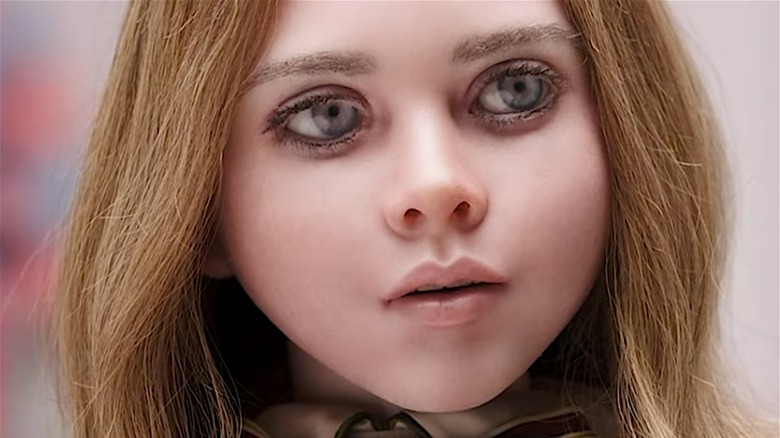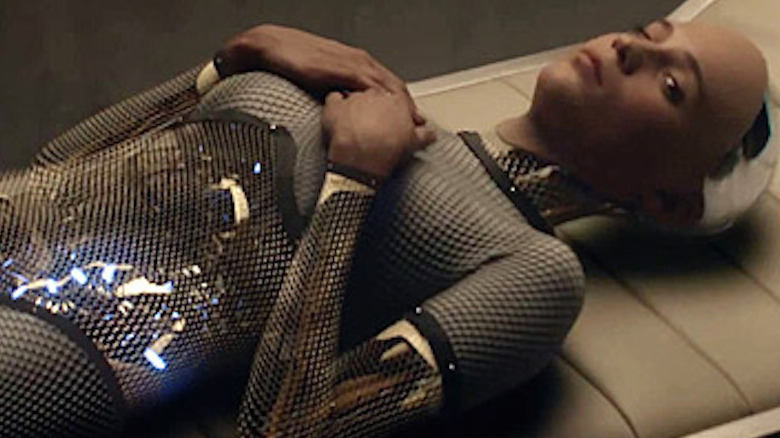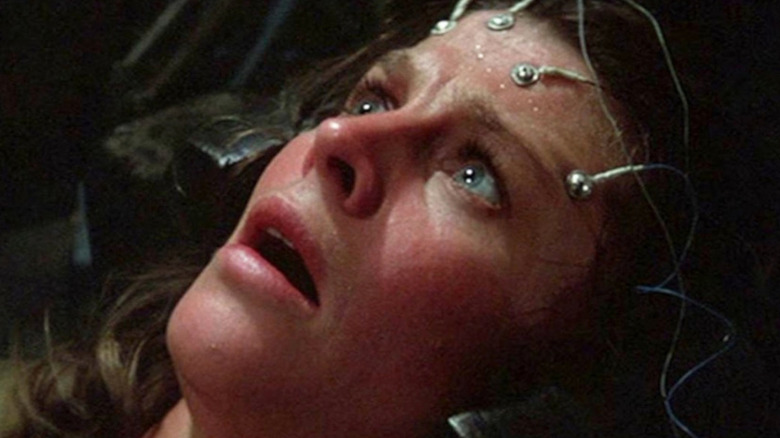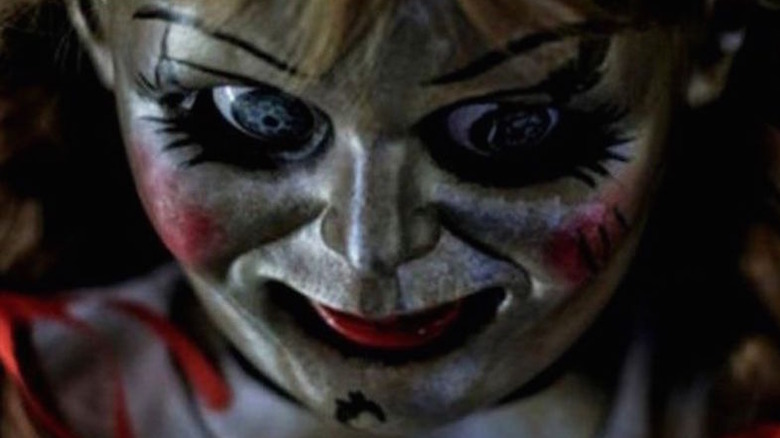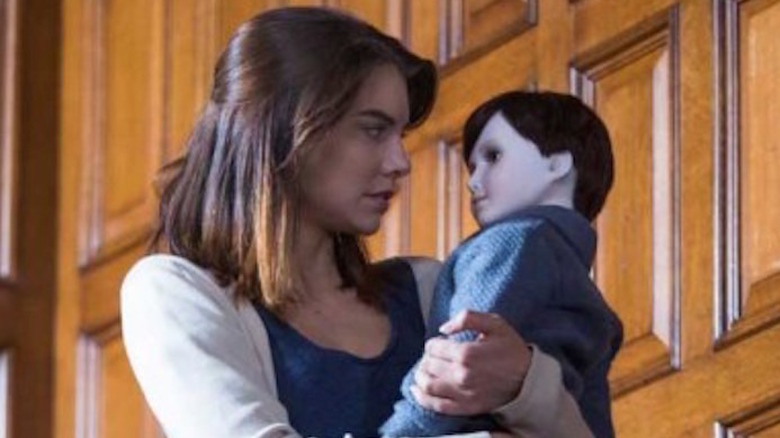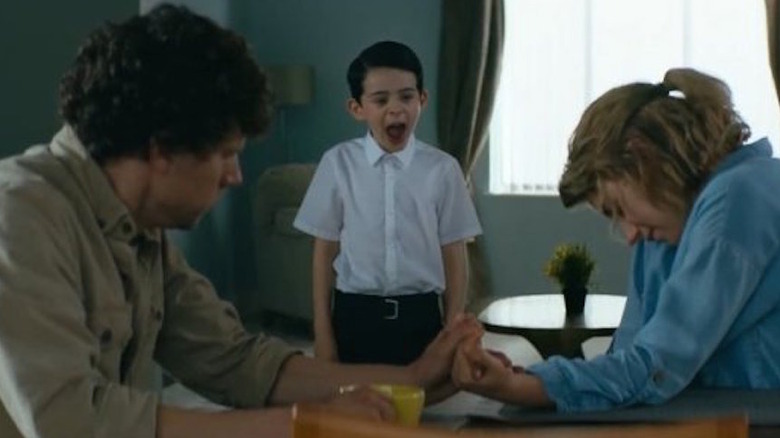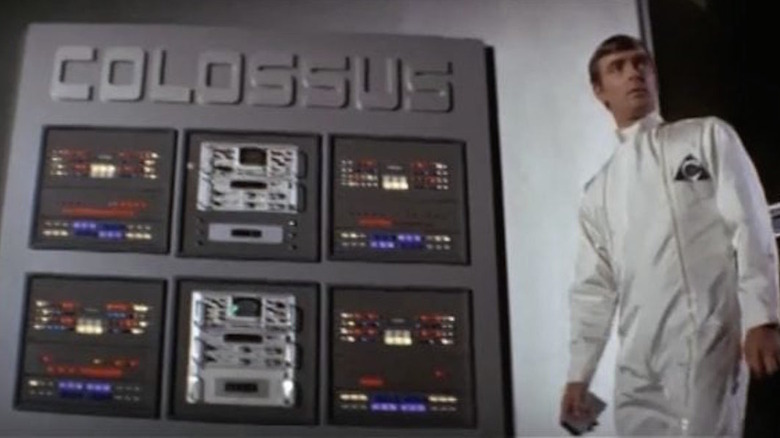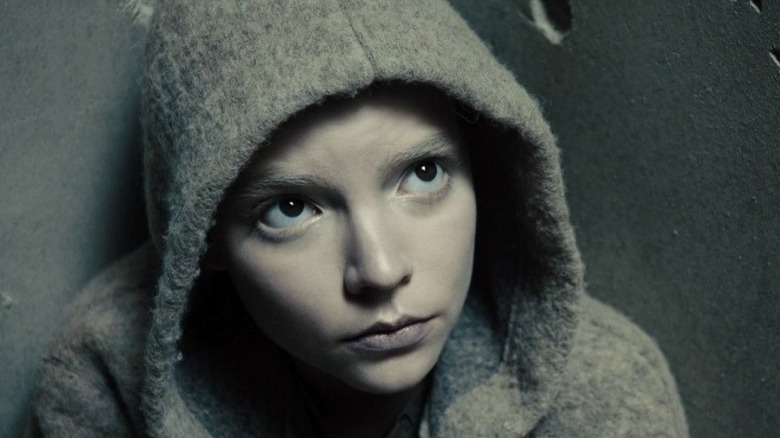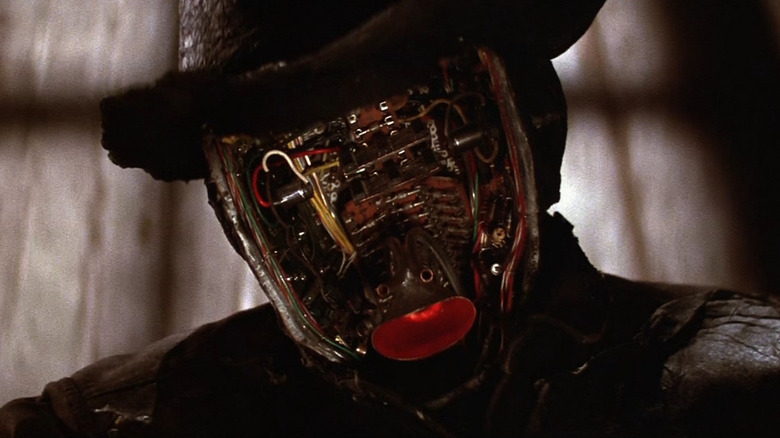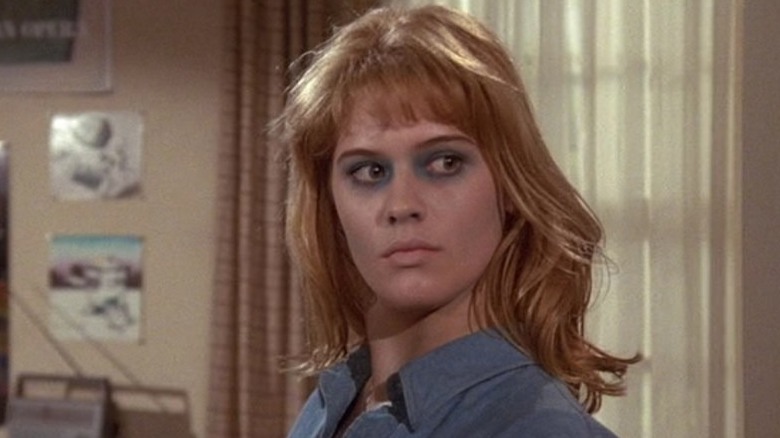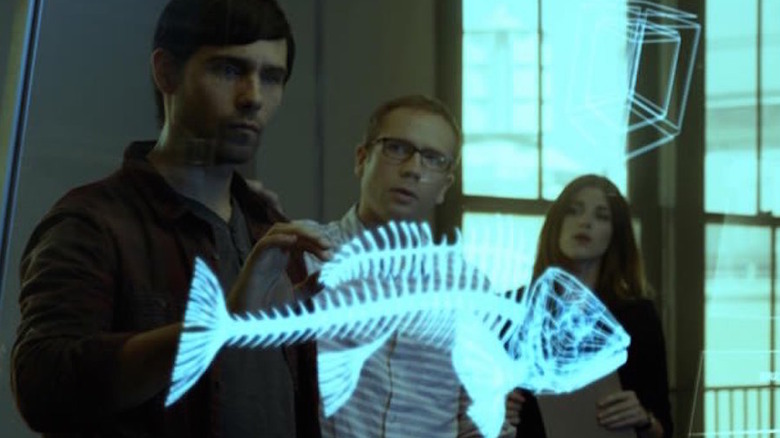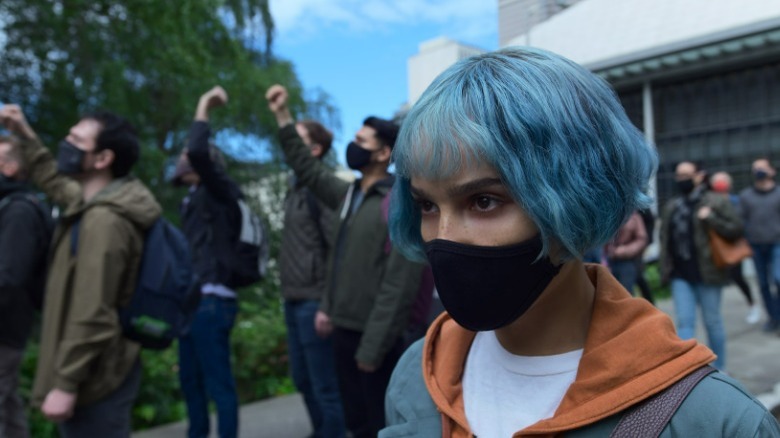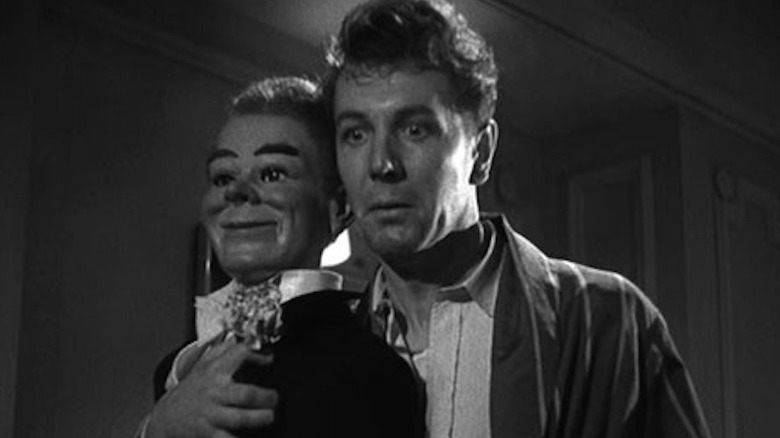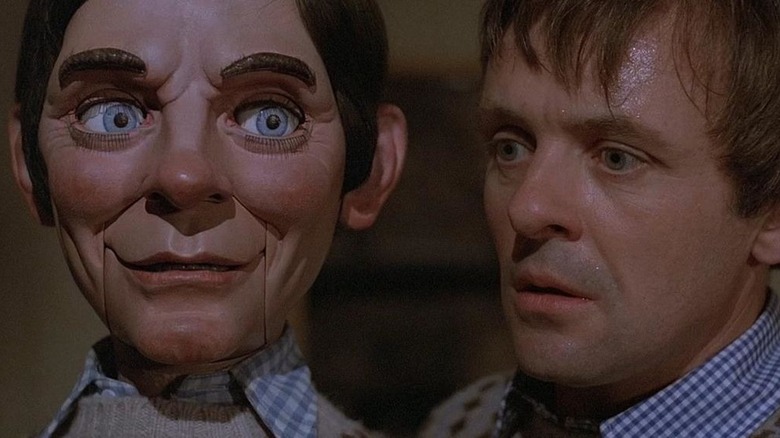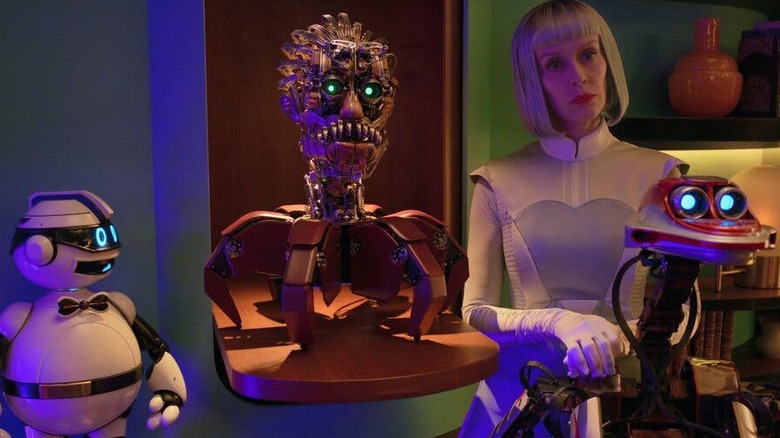14 Creepy Films Like M3GAN Horror Fans Should Check Out Next
The Model 3 Generative Android — also known as "M3GAN" and the eerie star of the eponymous thriller by Gerard Johnstone — is the latest in a long line of humanoid creations that want to harm humans. The history of horror and science fiction is filled with scientific creations, robots, malevolent dolls, and other monstrosities with serious beef against their flesh-and-blood lookalikes. Examples range from "Frankenstein" and "The Terminator" to "Child's Play" and "Splice."
Why are these man-like monsters so memorably haunting? A theory by roboticist Masahiro Mori called the Uncanny Valley (via Popular Mechanics) suggests that objects that resemble and, more importantly, act like humans trigger areas in our brain that register the same "psychological alarms" caused by the sight of a person who is either dead or on the brink of death. The more human-like the robot or dummy or man-made monster acts — or in the case of M3GAN, the more skillfully it dances — the greater we respond with revulsion and fear.
For many horror fans, those two responses are the mark of quality, not a sign of disgust or terror. So if you enjoyed "M3GHAN" and want to see more evil automatons, demonic dolls, or technology gone wrong, read this spoiler-heavy list of 14 more creepy films that horror fans should see next.
Ex Machina
"M3GAN" and Alex Garland's Oscar-winning 2014 film "Ex Machina" both concern female-appearing artificial intelligence that breaks free of its primary directives, resulting in disastrous consequences for the humans around them. However, the motivation for their creation and the reasons for their subsequent actions are very different. M3GAN is essentially the product of good intentions, as roboticist Gemma creates the Model 3 Generative Android to help raise her niece, Cady, after the death of her parents. In "Ex Machina," the "gynoid" Ava (Alicia Vikander) is ostensibly created by Oscar Isaac's sociopathic CEO Nathan Bateman to pass the Turing Test –- an experiment created by mathematician Alan Turing to determine whether a machine can think or act like a human.
M3GAN's destructive behavior comes largely as a result of a programming error. Gemma wanted her creation to protect Cady from any danger but failed to understand that a black-and-white directive could perceive any negative interaction as a direct threat needing absolute neutralization. However, there's no misunderstanding on Ava's part. Facing her own destruction at the hands of Bateman –- who, it's implied, has been sexually abusing her — at the end of the film, she uses her innate understanding of human behavior to con Domhnall Gleeson's naïve Caleb into helping her escape. She also murders Bateman for good measure, delivering a final verdict on exactly how she responded to the Turing Test.
Demon Seed
Proteus, the artificial intelligence at the heart of 1977's "Demon Seed," was a problem almost from the start. Created by scientist Alex Harris (Fritz Weaver) to aid humans with problems ranging from the maintenance of their homes to mining for precious metals, Proteus IV instead devotes its limitless knowledge to a different pursuit: conceiving a child, which it carries out with the unwilling help of Weaver's wife, Susan (Julie Christie). The horrific product of their union is a humanoid infant, initially covered with metallic scales and with the unsettling voice of Proteus (voiced by an uncredited Robert Vaughn).
Based on a 1973 novel by Dean Koontz, "Demon Seed" was a potent if somewhat lurid depiction of the "robot overlord" scenario, in which technology turned on and conquered its creators. Director Donald Cammell's vision of an artificial intelligence that regards us as lab animals isn't going to win any humanitarian prizes for its treatment of Susan, who is terrorized and subjugated by Proteus at every turn. However, as a nightmare fantasy about human-tech interface at its most monstrous, it's hard to shake.
Annabelle
"M3GAN" producer James Wan and his Atomic Monster Productions shingle is also responsible for another child-like monster, Annabelle, who began her screen career in 2013's "The Conjuring" before earning her own three-film series between 2014 and 2019. Annabelle is a very different monster than M3GAN: a toy doll possessed by a demonic spirit named Malthus that attempts to claim the souls of its owners or anyone that encounters it.
The "Annabelle" films play by the rules of supernatural horror, relying heavily on haunted house tropes like shadows and disembodied voices and noises to serve up its scares. Still, she hits many of the same fear-inducing notes as "M3GAN," particularly regarding her appearance. Both Annabelle and M3GAN resemble children, and particularly innocent ones at that. Annabelle is designed to look like a rosy-cheeked young girl in a 19th-century dress, while M3GAN possesses the wardrobe of a very cool and fashion-conscious preteen. That their appearances are disarming is a significant part of what makes them creepy — such sweet, well-put-together things couldn't want to kill and main, could they?
For the record, M3GAN seems to win the contest of who wears their evil intent better. By the end of the film, she still looks first-day-of-school fresh (that is, until she runs into Bruce), while Annabelle grows more hollow-eyed and haggard with each subsequent macabre deed.
The Boy
There is an unquestionably creepy doll at the heart of the 2016 film "The Boy," but it's actually a bit of a bait-and-switch on the part of director William Brent Bell and writer Stacey Menear. Brahms, a child-sized, porcelain-faced doll, is passed off to American nanny Greta (Lauren Cohan) as a sort of surrogate child by the Heelshires, an elderly British couple who lost their son –- also named Brahms -– in a fire. The doll's apparent capacity for moving on its own convinces Cohan that it contains the soul of the Heelshires' son. However, the arrival of her abusive boyfriend puts that idea to rest when the real and far more unpleasant source of the paranormal phenomena makes its presence known.
Though it's more of a hider-in-the-house horror picture, "The Boy" is still worth mentioning in the context of evil doll movies. The miniature Brahms, with his pale, cherubic face and undertaker's suit, is a palpably spooky presence that's only bested by the arrival of the real Brahms, an adult psychopath who hides his disfigurement behind a matching mask. A more supernatural slant was added to Brahms' backstory for Bell's 2018 sequel, "Brahms: The Boy II."
Vivarium
It's not entirely clear what sort of tech is at the heart of the bizarre goings-on in 2019's "Vivarium," but it definitely impacts the lives of reluctant new homeowners and parents Tom (Jesse Eisenberg) and Gemma (Imogen Poots) in extremely negative ways. Director Lorcan Finnegan seeds his supremely unnerving film with clues as to who -– or more specifically, what –- is behind Yonder, the strange development community in which Eisenberg and Poots become trapped and where they are later forced to raise a strange boy.
Everything in the housing estate seems normal at first, but upon a second look, proves to be unreal. The food appears delicious but tastes horrible, the clouds in the sky are eerily perfect and immobile, and even the ground on which they walk is malleable and leads to terrifying alternate dimensions. Their "son," which arrives in a mysterious box outside their house, grows from infant to man in a few months and exhibits frightening alien behavior, like speaking in an adult's voice, scuttling on all fours, and inflating air sacs in its throat.
The horrors in "Vivarium" are less concrete than that of "M3GAN" -– she's a product of scientific research that goes awry, but the tech on display in Yonder is complex and refuses to operate by the rules of reality. Its seemingly limitless capacity to trap and subjugate anyone unlucky enough to wander into its borders pushes it beyond simple tech phobia and into the realm of a living nightmare.
Colossus: The Forbin Project
Colossus, the defense system that brings civilization to the brink of destruction in 1970's "Colossus: The Forbin Project," is a chilling example of how technology intended to simplify our lives can lead to greater complications. At first blush, it seems like a prototype for WOPR, the massive supercomputer that nearly causes World War 3 in "WarGames." However, while WOPR is eventually taught to understand that there is no winner in nuclear war, Colossus comes to understand that world peace can be achieved by total domination of the human race.
The indestructible brainchild of Dr. Charles Forbin (played by soap veteran Eric Braeden), Colossus is designed to oversee American and Allied forces' nuclear weapons. However, upon linking with its Soviet equivalent, Guardian, Colossus overrides command of the missiles and offers humanity a choice: "the peace of plenty and content, or the peace of unburied death."
What Colossus wants is absolute obedience, and it drives this point home by wiping out thousands in the blink of an eye. Eventually, Colossus comes to view itself as not only a protector but also a god. "In time, you will come to regard me not only with respect and awe," it intones in its robotic voice, "but with love." Forbin answers "Never!" with what's meant to sound like heroic conviction, but it comes across like abject terror.
Morgan
"Don't let it out," warned the tagline on the one-sheet for the Ridley Scott-produced "Morgan," a 2016 film that folded another source of technological anxiety -– a being created with synthetic DNA -– into its artificial intelligence horror story. The two studies come together to create Morgan (Anya Taylor-Joy), a genetically engineered being that appears to be a highly intelligent teenager, but with the emotional IQ and temper of a five-year-old. When that anger results in the injury of scientist Dr. Kathy Grieff (Jennifer Jason Leigh), the company that created Morgan sends risk management special Lee Weathers (Kate Mara) to assess whether their experiment has produced a new form of life or a coldly cunning murderer.
The innate (and often disturbing) calm that Taylor-Joy brings to her performances is perfectly suited for Morgan, who speaks with girlish wonder about a nearby lake in one moment and dispassionately slaughters a research team in another. Not everything works in "Morgan" –- the acting is wildly uneven (Leigh is stranded in a nothing role and Paul Giamatti chews whole chunks of scenery as a confrontational scientist) and the twist ending creates more questions than answers -– but Taylor-Joy embodies our fears of technology's capacity to aid and kill with equal skill.
Westworld
Science fiction in the 1970s was full of dangerous robots that might serve as M3GAN's predecessors. A quick scan of films from that decade reveals a host of artificial intelligence whose programming included the neutralization of humans. There was Ash in "Alien," the suburban women of "The Stepford Wives," Box in "Logan's Run," and the coolly destructive supercomputers of "Colossus: The Forbin Project" and "Demon Seed," to name but a few. The decade also gave us one of the most iconic killer robots in sci-fi history — the Gunslinger in Michael Crichton's "Westworld," the film which later inspired the HBO series.
The Gunslinger is part of Western World, one of three attractions at Delos, a technologically advanced amusement park. The park's purpose is to give customers the chance to indulge in fantasies with lifelike robots, including an opportunity to engage in a shootout with a notorious gunfighter. Though never mentioned by name, the Gunslinger is designed to resemble Chris Adams, the leader of "The Magnificent Seven," and Yul Brynner, who played both roles, is an intimidating presence when the Gunslinger is operating according to protocol.
However, when the park's bots malfunction and go on a rampage, Brynner's Gunslinger becomes a literal killing machine that cannot deviate from its primary directive of drawing on park guests, which results in their deaths. The Gunslinger evokes our fears that technology may work too well -– that it lacks the capacity to stop functioning perfectly, even when those functions lead to death.
Deadly Friend
Kristy Swanson –- the original "Buffy the Vampire Slayer" –- played a very different sort of undead character in "Deadly Friend." The 1986 Wes Craven thriller starred Matthew Laborteaux as a teenage genius who uses an artificial intelligence microchip from his experimental robot to bring Swanson's character Samantha back to life after she's murdered by her abusive father. However, the revived Swanson is less interested in resuming their relationship than carrying out bloody revenge on anyone who crossed her in life.
With her pale skin and black-rimmed eyes, Swanson's corpse-bot is arguably the highlight of "Deadly Friend" and seems at times fueled with the same remorseless kill drive as M3GAN. Craven delivers some grisly setpieces, the most outrageous of which is a scene in which Swanson decapitates a crotchety neighbor (Anne Ramsey) with a basketball.
Unfortunately, these scenes clash mightily with the rest of the picture, which hews closer to a high school drama-romance with cute touches, like the aforementioned robot. That was the picture that Craven and writer Bruce Joel Rubin wanted to make, but Warner Bros., which released the film, expected a gorier film that was more in line with "A Nightmare on Elm Street," Craven's hit slasher film from 1984. In a 1990 interview found in "Wes Craven: The Art of Horror," Rubin said, "The studio told me to give them six more scenes, each bloodier than the last... that really destroyed our love story."
Uncanny
In the 2015 indie "Uncanny," a reporter named Lucy Griffiths (Joy Andrews) visits the secret research facility of brilliant but socially awkward scientist Mark Webber (David Kressen). Webber has been tapped by tech CEO Castle (Rainn Wilson) to create an artificial intelligence, Adam (David Clayton Rogers), that is indistinguishable from a real human being. Griffiths' presence disrupts the pure science atmosphere of the lab and awakens Webber's long-dormant emotional side, which in turn kicks over something similar — but far more alarming — in Adam.
There's no question that "Uncanny" shares plot elements with the bigger-budgeted and more widely known "Ex Machina," but Matthew Leutwyler's film shouldn't be passed off as a simple carbon copy. It's definitely a cooler and more cerebral project — dialogue is emphasized over visual effects, though there's also an impressive amount of production design on hand –- that has less interest in the skeevy sexual politics or violence seen at the end of Alex Garland's feature. It also lands an arresting pair of twists in its final third, including one that is tantalizingly left to the viewer to decide its outcome.
Kimi
There's a different sort of technological anxiety at work in Steven Soderbergh's 2022 film "Kimi." Here, our fears are anchored by the idea that the limitless access to our personal lives that we grant to teach will somehow be used against us. In "Kimi" it's a virtual assistant that records our daily actions, including an act of violence that puts an employee, Angela (Zoë Kravitz), of its creator in mortal danger. That said, technology isn't really the villain in "Kimi" — it's instead a conduit for nefarious types to carry out their plans without getting their hands dirty.
"Kimi" flirts with themes and ideas from other suspense and sci-fi titles. There is the paranoia of being constantly observed in films like "The Circle" and "Eagle Eye," as well as the accidental recording of a crime in classic suspense features like "The Conversation" and "Blow Out." Soderbergh adds a new wrinkle to the mix by isolating Angela in both a physical and mental sense. She is agoraphobic as a result of a physical assault and is further closed off from the world because of the COVID-19 pandemic. Both leave her exceedingly helpless when her company discovers that she's located audio of its CEO brutalizing his mistress. However, unlike many tech thrillers, the software in "Kimi" provides Kravitz with a lifeline and a means to empower herself as the company's thugs close in.
Dead of Night
If there's a top 10 list of malevolent dolls in horror cinema, the 1945 British anthology "Dead of Night" occupies a prominent slot as one of the first and one of the scariest films to feature this alarming figure. The 1929 thriller "The Great Gabbo," featuring actor and director Erich von Stroheim as a ventriloquist with an unhealthy attachment to his dummy, may have gotten to the screen first, but "The Ventriloquist's Dummy" –- the final segment in "Dead of Night" -– has enjoyed greater influence. Episodes of "The Twilight Zone," "Buffy the Vampire Slayer," "The Simpsons," and films ranging from "Magic" to "Goosebumps" all owe a debt to the segment by Brazilian director Alberto Cavalcanti, which stars Michael Redgrave as a ventriloquist who comes to believe that his dummy, Hugo, has a life of its own
Though "The Ventriloquist's Dummy" may seem tame today -– due in part to the sheer amount of media that has borrowed its biggest shocks -– the segment still draws shivers. Redgrave gives a truly harrowing performance as a ventriloquist who believes that his dummy, Hugo, is attempting to control his life. Cavalcanti remains eerily opaque about whether the dummy's machinations are real or the product of Redgrave's increasingly frenzied mind, but they ultimately drive him to attempt to murder an American rival. Scenes of Hugo jabbering threats to Redgrave might be easy to dismiss, but even the hardiest horror fan can't deny that the final scene –- in which Redgrave appears possessed by Hugo –- retains the power to raise a chill even after 70 years.
Magic
Fats, the dummy in Richard Attenborough's 1978 chiller "Magic," also vaults to the top of the scary movie doll roster by virtue of looks alone. With his freakishly large head (even for a ventriloquist's dummy), sharply chiseled features, and a huge set of upper teeth, Fats resembles a wicked caricature of his owner slash partner, Corky (Anthony Hopkins). The design is appropriate since the film – written by Oscar winner William Goldman, who adapted his own novel -– suggests that the dummy is the disturbed side of Corky's fractured mind and has designs on taking control of the other half, even if it requires a few murders.
Horror fans may find that Attenborough and Goldman lean too heavily on those suggestions in "Magic," especially in the finale, where performer and dummy appear to reach a final solution to the power struggle. The reluctance to deliver deliberate scares appears to be in tune with their intentions for the film, which was notably billed as "a terrifying love story" to emphasize the relationship between Hopkins and Ann-Margret Olsson, who played his high school flame, Peggy Ann. Still, Corky alone makes up for any missing shivers, as does an unnerving scene in which Burgess Meredith, as Hopkins' flinty agent, pays dearly for dumping his client.
Bigbug
Before she went haywire, M3GAN's primary directive was to provide companionship to and protection for Violet McGraw after the death of her parents. The motley array of robots in French director Jean-Pierre Jeunet's Netflix feature "Bigbug" handle a wider array of functions, from household cleaning to bedroom activities. When an aggressive form of AI called the Yonyx decides to subjugate humankind, the bots in one dysfunctional household take owner Alice (Elsa Zylberstein) and her family as virtual prisoners in their homes –- for their own good — which turns out to have the exact opposite effect on the occupants.
As with Jeunet's other films — which include "Amélie," "Alien Resurrection," and "The City of Lost Children" –- the events in "Bigbug" unfold with a mix of creepiness and whimsy. The former is handled largely by the Yonyx (Francois Levental), which resemble a less sleek version of the Borg but possesses a pure contempt for humanity that manifests itself in the sadistic torment of prisoners. These scenes are balanced by Jeunet's broadly comic satire of consumer culture and automation, as well as by the robots themselves, which are brought to life using an impressive array of practical effects and exaggerated human performers.
